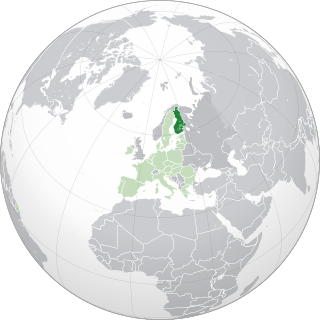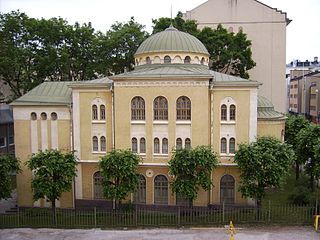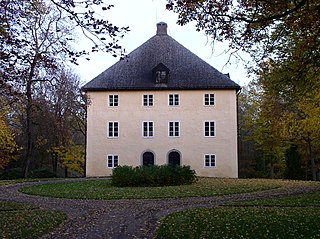
Helsinki is the capital, largest and most populous city in Finland. Located on the shore of the Gulf of Finland, it is the seat of the Uusimaa region in southern Finland and has a population of 673,011. The city's urban area has a population of 1,268,296, making it by far the most populous urban area in Finland and the country's most important centre for politics, education, finance, culture and research. Helsinki is located 80 kilometres (50 mi) north of Tallinn, Estonia, 400 km (250 mi) east of Stockholm, Sweden, and 300 km (190 mi) west of Saint Petersburg, Russia. It has close historical links with these three cities.

The Royal Academy of Turku or the Royal Academy of Åbo was the first university in Finland, and the only Finnish university that was founded when the country still was a part of Sweden. It was founded in 1640. In 1809, after Finland became a Grand Duchy under the suzerainty of the Russian czar, it was renamed the Imperial Academy of Turku. In 1828, after the Great Fire of Turku, the institution was moved to Helsinki, in line with the relocation of the Grand Duchy's capital. It was finally renamed the University of Helsinki when Finland became a sovereign nation-state in 1917.

Åbo Akademi University is the only exclusively Swedish language multi-faculty university in Finland. It is located mainly in Turku but has also activities in Vaasa. Åbo Akademi should not be confused with the Royal Academy of Åbo, which was founded in 1640, but moved to Helsinki after the Turku fire of 1827 and is today known as the University of Helsinki.

The University of Turku, located in Turku in southwestern Finland, is the third largest university in the country as measured by student enrollment, after the University of Helsinki and Tampere University. It is a multidisciplinary university with eight faculties. It was established in 1920 and also has facilities at Rauma, Pori, Kevo and Seili. The university is a member of the Coimbra Group and the European Campus of City-Universities (EC2U).

Havis Amanda is a fountain and a statue in Helsinki, Finland by the sculptor Ville Vallgren (1855–1940). The work was modelled in 1906 in Paris, and erected at its present location at the Market Square in Kaartinkaupunki in 1908. Today it is recognized as one of the most important and beloved pieces of art in Helsinki.

Kamppi is a neighbourhood in the centre of Helsinki, the capital of Finland. The name originally referred to a small area known as the "Kamppi field", but according to the current official designation, "Kamppi" encompasses a much larger area with a population of 10,000 in 2004.

Kupittaa is a district in Turku, Finland. It is located on the eastern side of the city's centre, around the Kupittaa Park, the first landscaped park in a Finnish city. The district serves as a centre for recreation and business. Turku has recently planned a residential area for 750 residents on the premises of a former HKScan sausage factory.

Maaria is a former municipality of Finland in what is now the northern part of the city of Turku. The area has been inhabited since the Iron Age, and it became an important village in the 15th century with the construction of a church dedicated to the Virgin Mary. Also Koroinen, with the former residence of the Bishop of Finland is in the area. The municipality of Maaria was founded in 1868, and it included the northern parts of modern Turku south of Paattinen, some enclaves to the north of Paattinen, and the island of Hirvensalo to the south of Turku.

Pasila station is a railway station in Helsinki, Finland, approximately 3.5 kilometres (2.2 mi) north of Helsinki Central. It is the second busiest railway station in Finland, after Helsinki Central, and takes up a large part of the district of Pasila. The station was first opened in 1862 along the Finnish Main Line. The current station building opened in 2019.

The history of the Jews in Finland goes back to the 1700s. The country is home to some 1,800 Jews, of which 1,400 live in the Greater Helsinki area and 200 in Turku. Most Jews in Finland have Finnish or Swedish as their mother tongue, and many speak Yiddish, German, Russian and Hebrew. Jews originally came to Finland as Russian soldiers who stayed in Finland in the 19th century after their military service ended. There are Jewish congregations in Helsinki and Turku with their own synagogues built in 1906 and 1912. The Wiborg Synagogue built 1910–1911 was destroyed in air bombings during the first day of the Winter War in 30 November 1939. Since data collection began in 2008, incidents of antisemitism have been on the rise in Finland. The number of incidents are likely under-reported as Finland does not account for specific forms of hate speech that incite violence or hatred.

The University of Helsinki Botanical Garden is an institution subordinate to the Finnish Museum of Natural History of the University of Helsinki, which maintains a collection of live plants for use in research and teaching. The Botanical Garden has two separate sites: one in Kaisaniemi and one in Kumpula.

Hietalahti shipyard is a shipyard in Hietalahti, in downtown Helsinki, Finland. Since 2019, it has been operated by a company named Helsinki Shipyard.

Turku Synagogue in the city of Turku is one of the two synagogues in Finland. Located in the VII District, the synagogue is used by the Jewish community of Turku. The synagogue building, designed by architects August Krook and J.E. Hindersson, was completed in 1912.

The herring market or herring fair is an annual event held in various cities in Finland, notably in Helsinki in October. During the Helsinki herring market, many archipelagoans arrive in the South Harbour to sell fish and other archipelago products directly from their boats. The event is organised by the city of Helsinki.

Turku Cemetery is a cemetery inaugurated in 1807 and located in Vasaramäki on the south-eastern outskirts of the city of Turku.

Nylands Nation (NN) is one of the 15 student nations at the University of Helsinki, Finland's oldest, Swedish-speaking and established in 1643 at The Royal Academy of Turku. In 1828, the Academy moved to Helsinki taking the name "University" and Nylands Nation moved there along with the other Nations. Since 1904 the house of Nylands Nation, a building designed by Karl Hård af Segerstad, has stood at Kasarmikatu 40.

Kankainen Manor is a late medieval manor in Masku, Finland, located along a small river about one kilometre south of Masku town centre. Kankainen Manor is considered to be the oldest surviving residential building in Finland, as its oldest parts may be from the end of the 15th century. In 2009, the Finnish Heritage Agency defined it as one of Finland's nationally significant built cultural environments.
The Lentorata is a planned railway line in Finland, designed to link Helsinki Airport to the Finnish long-distance railway network and to complement the current airport connection via the Ring Rail Line. Construction of the line is not expected to start until 2030, with the line operational several years later.

The Turku barracks was a barracks building for the military of Russia built in 1833 in Kamppi, Helsinki, Finland, along the street Läntinen Henrikinkatu.

Kappeli, also known as Esplanadikappeli, is a restaurant in central Helsinki, Finland at the eastern end of the Esplanadi park, opened in 1867. The restaurant was known as a local favourite among poets, writers and artists during the late 19th and early 20th centuries. In August 2020 the building changed ownership from the city of Helsinki to HOK-Elanto, who currently also owns the restaurant itself.






















